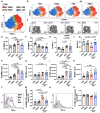Placental mesenchymal stem cells boost M2 alveolar over M1 bone marrow macrophages via IL-1β in Klebsiella-mediated acute respiratory distress syndrome
- PMID: 35450943
- PMCID: PMC10176360
- DOI: 10.1136/thoraxjnl-2021-217928
Placental mesenchymal stem cells boost M2 alveolar over M1 bone marrow macrophages via IL-1β in Klebsiella-mediated acute respiratory distress syndrome
Abstract
Rationale: Acute respiratory distress syndrome (ARDS) is a lethal complication of severe bacterial pneumonia due to the inability to dampen overexuberant immune responses without compromising pathogen clearance. Both of these processes involve tissue-resident and bone marrow (BM)-recruited macrophage (MΦ) populations which can be polarised to have divergent functions. Surprisingly, despite the known immunomodulatory properties of mesenchymal stem cells (MSCs), simultaneous interactions with tissue-resident and recruited BMMΦ populations are largely unexplored.
Objectives: We assessed the therapeutic use of human placental MSCs (PMSCs) in severe bacterial pneumonia with elucidation of the roles of resident alveolar MΦs (AMΦs) and BMMΦs.
Methods: We developed a lethal, murine pneumonia model using intratracheal infection of a clinically relevant Klebsiella pneumoniae (KP) strain with subsequent intravenous human PMSC treatment. Pulmonary AMΦ and recruited BMMΦ analyses, histological evaluation, bacterial clearance and mice survival were assessed. To elucidate the role of resident AMΦs in improving outcome, we performed AMΦ depletion in the KP-pneumonia model with intratracheal clodronate pretreatment.
Measurements and main results: Human PMSC treatment decreased tissue injury and improved survival of severe KP-pneumonia mice by decreasing the presence and function of recruited M1 BMMΦ while preserving M2 AMΦs and enhancing their antibacterial functions. Interestingly, PMSC therapy failed to rescue AMΦ-depleted mice with KP pneumonia, and PMSC-secreted IL-1β was identified as critical in increasing AMΦ antibacterial activities to significantly improve pathogen clearance-especially bacteraemia-and survival.
Conclusions: Human PMSC treatment preferentially rescued resident M2 AMΦs over recruited M1 BMMΦs with overall M2 polarisation to improve KP-related ARDS survival.
Keywords: ARDS; bacterial Infection; macrophage biology; respiratory infection.
© Author(s) (or their employer(s)) 2023. Re-use permitted under CC BY-NC. No commercial re-use. See rights and permissions. Published by BMJ.
Conflict of interest statement
Competing interests: None declared.
Figures







References
Publication types
MeSH terms
LinkOut - more resources
Full Text Sources
